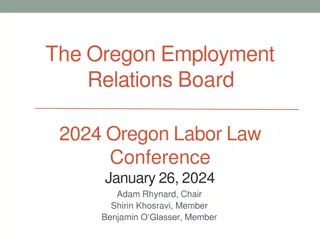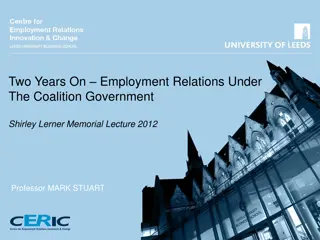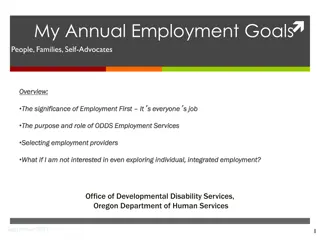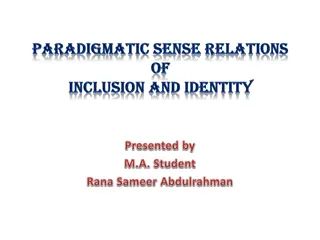Public Service Employment Relations in South Africa: Overview
The South African public service employment relations are governed by various acts including the Labour Relations Act, Basic Conditions of Employment Act, and others. The legal framework emphasizes collective bargaining, with the Public Service Coordinating Bargaining Council playing a key role. The Constitution sets clear guidelines for employment relations, with a focus on economic development, social justice, and labor peace.
Download Presentation

Please find below an Image/Link to download the presentation.
The content on the website is provided AS IS for your information and personal use only. It may not be sold, licensed, or shared on other websites without obtaining consent from the author. Download presentation by click this link. If you encounter any issues during the download, it is possible that the publisher has removed the file from their server.
E N D
Presentation Transcript
Public Service Employment Relations in South Africa Frikkie De Bruin South Africa 1
Introduction Generally, the South African labour market is regulated by the Labour Relations Act (LRA) and Basic Conditions of Employment Act (BCEA) In addition to the LRA and BCEA, public service employment is also regulated by the Public Service Act, South African Police Service Act, Employment of Educators Act and the Correctional Services Act and other. Which also sets out some of the important laws for the employment conditions of the public service in South Africa. 2
Introduction It has been argued that, the South African Labour Relations Act is favouring labour and therefore offer favourable conditions for workers and in the process, empowering the trade unions. In the Public Service this perception is even more prevalent in that the Labour Relations Act in stills a right to collective bargaining. Section 35-37 of the South African Labour Relations Act establishes the Public Service Coordinating Bargaining Council (PSCBC), it legislates who will be the parties and it determines the agenda 3 on what will be the issues to be discussed.
Legal Framework Regulating Public Employment Relations The South African Constitution supersedes all other acts of the country and all South African statutes must conform to the basic principles contained in the Constitution. The Constitution provides clear guidelines with regards to employment relations. The Labour Relations Act is a centrepiece of the labour law in South Africa and all labour laws are subordinate to the LRA. The main purpose of the Labour Relations Act is to advance economic development, social justice, labour peace and a 4 democratisation of the workplace by fulfilling the primary objectives of the Act.
Legal Framework Regulating Public Employment Relations Basic Conditions of Employment Act (BCEA) is to advance economic development and social injustice by establishing and enforcing basic conditions of employment. Other Legislation such as the Employment Equity Act, Skills Development Act and different Acts requiring specific action from Government Departments in performing specific functions Collective Agreements, legislation provides for a collective agreement to be binding and enforceable as if it is law. The LRA allows for collective agreements to 5 override contracts of employment and certain parts of provisions in legislation.
Collective Bargaining The Public Service Coordinating Bargaining Council (PSCBC) was established to cater for public service collective bargaining. PSCBC is an independent forum where the employer (state) and the admitted trade unions to the PSCBC, meet to negotiate and sign collective agreements that regulate the terms and conditions of public servants. The PSCBC only discuss or engage on issues of transverse nature, a matter that 6 will have an effect across the public service.
Public Service Collective Bargaining Structure The public service bargaining structure further consist of four sectoral councils tailored to serve specific sectors of public service.; The Education Labour Relations Council (ELRC) focuses on the education sector. The Safety & Security Sectoral Bargaining Council (SSSBC) which serves the Police Public Health and Social Development Sectoral Bargaining Council (PHSDSBC) serving the health sector and social development. The General Public Service Sector Bargaining Council (GPSSBC) which covers everyone else not covered under any of the above mentioned sector councils. 7
The Increasing Power of Public Sector Unions Unions have increased their influence in the workplace against, what is perceived to be the normal world trend. Membership statistics also indicate that unions are still considered relevant by the membership (98% of Public Service is unionised). The concept of Political Stability; with the alliance between the governing African National Congress and the Congress of South African Trade Unions suggests that the public sector and unions share a common interest in enabling and implementing democratic-era policies. 9
The Increasing Power of Public Sector Unions Concept of unionised public-sector workers are also far more likely to have a secure working conditions than private-sector and non- unionised workers. In the public service, even non-unionises employees benefits from collective bargaining agreements. However, non-unionises employees pay an agency fee (agency fee payers around 220 000). The object of the agency fee is to ensure that all employees who receive the benefits of collective bargaining contribute towards its costs. 10
Remuneration in the Public Service According to research published by the Development Policy Research Unity from the University of Cape Town in 2014, the real monthly wage of an average public sector employee is R11, 668 (29 170 Mauritian rupee) compared to R7, 822 ( 19 555 Mauritian rupee) for an average private sector worker. 11
Remuneration in the Public Service The report stated that public sector workers are more unionised than private sector workers, which gives them more power to negotiate wages; In addition, public sector wages have less dispersion than private sector wages, indicating a lower level of wage inequality within the public sector; These general annual salary adjustments include the cost-of-living adjustment, annual pay progression and grade progression. Employees 12 qualify for pay progression based on satisfactory performance
Remuneration in the Public Service The purpose of the annual cost-of-living adjustments is to preserve the buying power of the employees, in order to ensure that their salaries are not eroded by inflation. Employees in the Public Service qualify for a guaranteed package that includes basic salary, the annual service bonus that equals an employee s one month salary payable in the public service as a 13th cheque and the employer contribution to the Government Employees 13 Pension Fund
Remuneration in the Public Service All public service employees appointed on permanent basis are required as a condition of service, to become members of the Government Employees Pension Fund. The State provides medical assistance in a form of subsidies for employees in the public service and as well as to retired employees who belong to registered medical schemes and who are eligible in terms of the policy governing post-retirement medical assistance. A housing allowance is also payable to public service employees. 14
Conclusive Remarks The public sector is highly unionised at a rate of 98% out of 1,3 million public servants. Public sector trade unions dominate union membership in South Africa. The increasing power of public sector trade unions has been argued to be the key drive to better remuneration, benefits and stable working conditions in the public service. 15
Conclusive Remarks The alliance between political parties and trade unions strengthens the power of trade unions to act in the best interest of their members. Public sector unionisation seems to be much more effective than the private sector and has undoubtable yielded more positive results. The legislative nature of collective bargaining in the Public Sector enhances the effectiveness of the principle of collective bargaining. An environment with strong collective bargaining structures, is an environment 16 that is more stable in their employment relationship.

 undefined
undefined




























